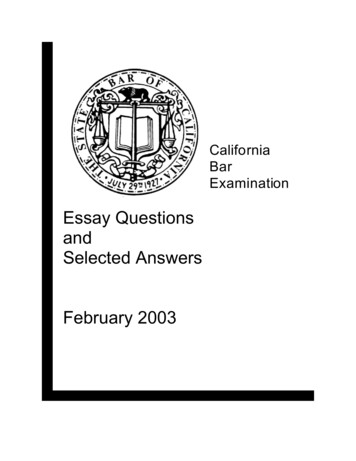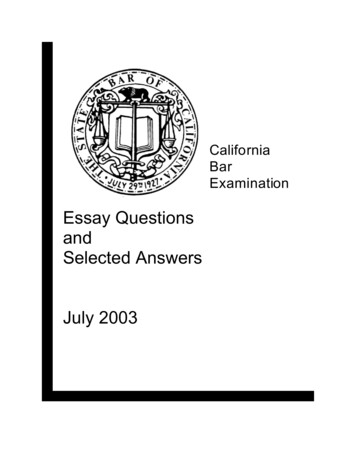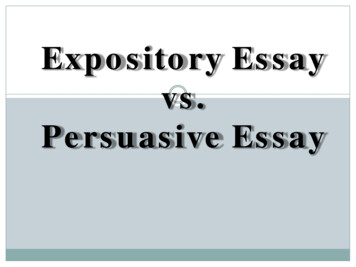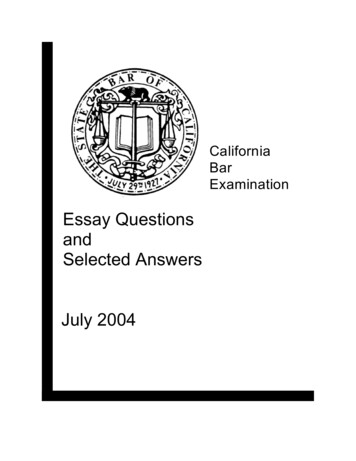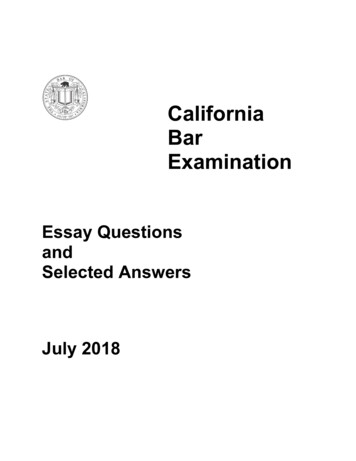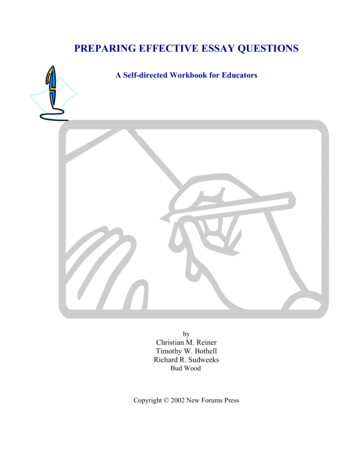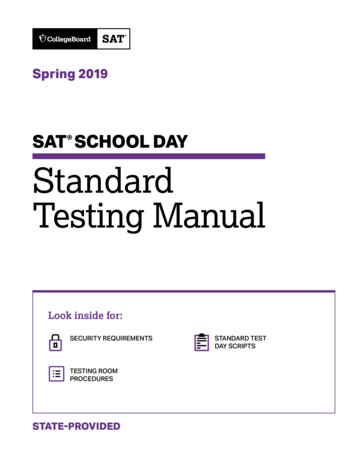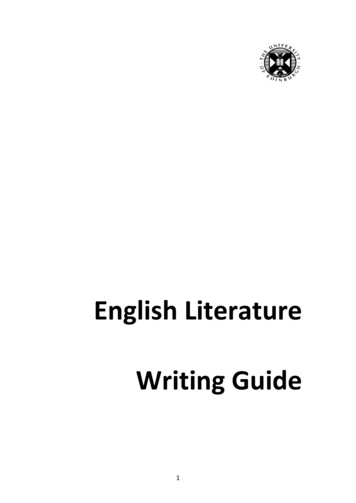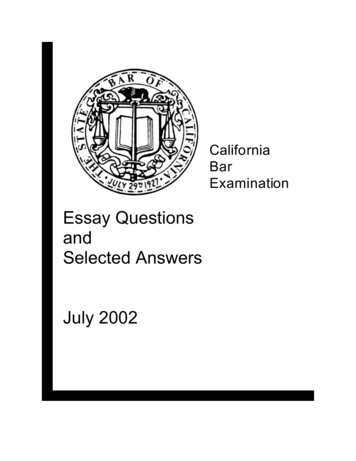
Transcription
CaliforniaBarExaminationEssay QuestionsandSelected AnswersJuly 2002
ESSAY QUESTIONS AND SELECTED ANSWERSJULY 2002 CALIFORNIA BAR EXAMINATIONThis publication contains the six essay questions from the July 2002 California BarExamination and two selected answers to each question.The answers received good grades and were written by applicants who passed theexamination. The answers were prepared by their authors, and were transcribedas submitted, except that minor corrections in spelling and punctuation were madefor ease in reading. The answers are reproduced here with the consent of theirauthors and may not be reprinted.Question NumberContentsPage1.Wills12.Real Property103.Professional Responsibility204.Contracts325.Torts416.Community Property53-i-
ESSAY EXAMINATION INSTRUCTIONSYour answer should demonstrate your ability to analyze the facts in thequestion, to tell the difference between material facts and immaterial facts, and todiscern the points of law and fact upon which the case turns. Your answer shouldshow that you know and understand the pertinent principles and theories of law,their qualifications and limitations, and their relationships to each other.Your answer should evidence your ability to apply the law to the given factsand to reason in a logical, lawyer-like manner from the premises you adopt to asound conclusion. Do not merely show that you remember legal principles.Instead, try to demonstrate your proficiency in using and applying them.If your answer contains only a statement of your conclusions, you will receivelittle credit. State fully the reasons that support your conclusions, and discuss allpoints thoroughly.Your answer should be complete, but you should not volunteer informationor discuss legal doctrines which are not pertinent to the solution of the problem.Unless a question expressly asks you to use California law, you shouldanswer according to legal theories and principles of general application.- ii -
QUESTION 1Theresa and Henry were married and had one child, Craig. In1990, Theresa executed a valid will leaving Henry all of herproperty except for a favorite painting, which she left to hersister, Sis. Theresa believed the painting was worth less than 500.On February 14, 1992, Theresa typed, dated, and signed a note,stating that Henry was to get the painting instead of Sis.Theresa never showed the note to anyone.In 1994, Theresa hand-wrote a codicil to her will, stating: AThenote I typed, signed, and dated on 2/14/92 is to become a partof my will.@ The codicil was properly signed and witnessed.In 1995, Theresa s and Henry s second child, Molly, was born.Shortly thereafter, Henry, unable to cope any longer withfatherhood, left and joined a nearby commune. Henry andTheresa never divorced.In 1999, Theresa fell in love with Larry and, with her separateproperty, purchased a 200,000 term life insurance policy onher own life and named Larry as the sole beneficiary.In 2000, Theresa died.Molly, Sis, and Larry.She was survived by Henry, Craig,At the time of her death, Theresa s half of the communityproperty was worth 50,000, and the painting was herseparate property. When appraised, the painting turned out tobe worth 1 million.What rights, if any, do Henry, Craig, Molly, Sis, and Larry haveto:1.Theresa’s half of the community property? Discuss.2.The life insurance proceeds? Discuss.1
3.The painting? Discuss.Answer according to California law.ANSWER A TO ESSAY QUESTION 1Theresa’s half of the Community PropertyThe parties’ rights to Theresa’s (T) one-half of the community property (CP)depends upon the validity of her will and upon CP legal principles.California is a CP State. All property acquired during marriage is presumed CP.All property acquired before married is presumed separate property (SP). Also,property acquired after permanent physical separation is presumed SP. Inaddition, property acquired any time through gift, devise, or descent is presumedSP.In order to characterize assets, courts allow tracing to the source of funds usedto acquire the asset. Generally, a mere change in form will not alter thecharacterization of an asset.At death, a testator has testamentary power to dispose of one-half of her CP andall of her SP.Here, T had the power to dispose of her ½ of the CP.Validity of T’s 1990 WillIn 1990, T executed a valid will. Thus, it is presumed that the will was properlysigned and attested by two witnesses.T left “all of her property” except the painting to Harry (H).beneficiary of T’s ½ of the CP.2Thus, H is the
A will can be revoked by a subsequent express written instrument or by aninconsistency. Here, T wrote a note in 1992 and a hand-written codicil in 1994.Both of these documents relate to the painting and not T’s CP.It does not appear that either document expressly revoked the 1990 will. Also,there are no facts indicating that the 1990 will was revoked by physical act.As a result, H would offer the 1990 will into probate and argue he is entitled to allof T’s ½ of CP valued at 50,000.Molly’s Rights as Pretermitted HeirMolly may argue she was omitted from T’s will because she was not born yet.Thus, Molly may argue she is entitled to share of T’s CP.A pretermitted child is one born or adopted after a will was executed. Theomitted child is entitled to an intestate share unless the omission was intentional;the child was provided for outside the will or the property was left to a parentwhen another child was alive at the time of the execution.Here, Molly was born in 1995, which is after the 1990 will was executed.However, all of the property was given to H. Furthermore, Craig, another child,was alive when the 1990 will was executed. As such, Molly would be unable torecover under this exception.Also, Molly would only by entitled to her interstate share. Under California law,when a person dies without a will allows their CP goes to a surviving spouse.Here, even if T died without a valid will, H would take all of the property underintestacy laws. Molly would only be entitled to a portion of T’s SP.Thus, Molly has no right to T’s CP.Craig’s Rights to T’s CPCraig is not a pretermitted child because he was alive at the time the 1990 willwas executed. Also, similarly to Molly, Craig would have no right to T’s CP underintestacy laws.3
Sis and Larry’s Rights to T’s CPSis is T’s sister. The intestate laws do not allow a sibling to take the testator’sCP when the surviving spouse with rights to that CP is still alive. T did not deviseany of her CP to Sis. As such, Sis has no rights in T’s CP.Larry appears to have been someone T fell in love with after H left. T neverdevised any of her CP to Larry. Larry has no rights in T’s CP.H will take T’s CP worth 50,000.T’s Life Insurance ProceedsOrdinarily under CP principles, proceeds from a whole life insurance are CP tothe extent they were acquired during marriage. The time rule is applied todetermine the CP interest. Proceeds from a term life insurance policy aregenerally the type of the last premium paid.H may argue in 1999 when T bought the life insurance policy they were stillmarried and therefore the 200,000 is CP. If so, Larry as the named beneficiarywould only be entitled to 100,000 as T has power to dispose of her ½ interest.Larry would argue T and H’s marriage had ended. A community ends with aphysical separation with the intent not to resume. Larry will argue H left andjoined a commune. Larry would assert this shows H’s intent to end the marriage.Larry will also argue and CP presumptions will be rebutted by tracing the sourceof the life insurance proceeds. T bought the life insurance with her own SP.Therefore, Larry will successfully argue even if T was still married and hereconomic community had not yet ended, she used her SP to acquire the policy.Since T used SP to buy the policy, the 200,000 proceeds would be SP as well.A mere change in form does not alter the characterizations of property. Thus,Larry would argue as the sole beneficiary he should take all the proceeds since Thas the power to dispose of all her SP.Craig and Molly’s Rights to the Life Insurance ProceedsThe children may attempt to argue they have a right to a portion of the 200,000.However, they will not succeed. They were both alive when T made this “will4
substitute” and T had the power to give the proceeds all to Larry and none tothem.Sis also has no claim to the proceeds.Thus, Larry is entitled to all of the life insurance proceeds valued at 200,000.The PaintingT’s 1990 WillIn her 1990 will, T devised the painting she thought was worth 50,000 to Sis.Therefore, under the 1990 will, Sis is entitled to the painting.The Effect of the 1992 NoteA codicil is an instrument made after the execution of a will that disposesproperty. A codicil must be executed with the formalities of a will.Formal Attested CodicilIn order for typewritten codicil to be given effect it must be signed by the testator.Also, the testator must sign or acknowledge her signature or will in front of twowitnesses. Those two witnesses must sign the will with the understanding that itis a will.Here, T did type, date and sign a note in 1992. This note purported to changeher 1990 will so that H got the painting and not Sis.However, T never showed the note to anyone. That implies she never had twowitnesses sign the note. Also, she never acknowledged her signature or will totwo witnesses. Therefore, it was not properly attested to. As a result, the codicilwill not be given effect.Holographic CodicilA holographic codicil is valid when all material provisions are in the testator’shandwriting and she signs it.5
Here, the note was typed and so it was not handwritten. Thus, it will not be giveneffect.Revocations by Express Subsequent CodicilA will can be revoked by a codicil. However, the codicil must be valid and meetthe formalities of a will in order to be given effect as a revocation.Here, as shown above the codicil was not executed by proper formalities. Thus,it did not revoke the 1990 will.By itself, the 1992 note has no effect on the 1990 will. Thus, Sis would still bethe beneficiary.Effect of the 1994 CodicilThe codicil written in 1994 was handwritten. It was also properly signed andwitnessed. It appears T was attempting to validate her 1992 not by stating “thenote I typed on 2/14/92 is to become a part of my will.”Incorporation by ReferenceA document can be incorporated by reference. It must have been in existence atthe time of the will execution, sufficiently described in the will and reasonablybeen the document the will was referring to.Here, the note was in existence at the time the codicil was written. The codicilwas written in 1994 as is attempting to incorporate the 1992 note. The codicil didsufficiently describe the note by stating “The note I typed, dated and signed on2/14/92.” The description accurately gives the date the note was made.H would offer the note and argue it sufficiently was described. Also, H will arguethe note is the document the codicil was referring to.As such, a court may find that the prior defective note has now been republishedand reexecuted by this 1994 codicil that was handwritten and signed. Eventhough a holographic codicil does not require attested witness, the fact that itwas properly witnessed should not preclude the court from finding it a validholographic codicil.6
Therefore, it is very likely H will prevail and will take the painting over Sis.Craig and Molly’s Rights to the PaintingThe children may argue since T was significantly mistaken about the paintingvalue, the gift to either Sis or H is invalid.The children will attempt to argue if T knew the painting was worth 1 million shewould have not given it to Sis. Rather she would have left it to them.A court will not likely agree with this argument. Existing evidence of a mistake isgenerally allowed if it is reasonably susceptible with the will.Here, it is not reasonable to assume T would have given it to Craig and Molly.She may have left it to H as she did not in the codicils.Therefore, the children likely have no right to the painting.They may argue H’s rights were revoked by operation of law.A gift to a spouse is revoked upon divorce.Here, T and H never divorced. As such, H likely takes the painting because alegal separation may not be enough to invoke revocation by law.7
ANSWER B TO ESSAY QUESTION 11. Theresa’s (T’s) Half of Community PropertyCalifornia is a community property state. Under California law, a spouse maydispose of one half of the community property through her will. Theprovisions of T’s will will control the 50,000 (her half of the communityproperty) unless a legal presumption prevents or alters application of the will.1990 WillThe 1990 will was “validly executed” (a will is validly executed when signedwith testamentary intent by a testator before two witnesses who know that thedocument is a will). The devise of 50,000 to Henry (H) and the painting toSis (S) are therefore valid unless modified by later wills or legal presumptions.1992 Note Is Not Valid Alone But Is Valid After 1995 CodicilThe 1992 note was not a valid modification when written. The note is typedand unwitnessed (never shown to anyone). A codicil to a will must satisfy thesame formalities of execution, as the original will. A codicil is valid if madewith testamentary intent before two witnesses who knows the document is awill. Here, T never showed the note to anyone, so it is unwitnessed.Holographic Wills – unwitnessed wills prepared by the testator – are validonly if signed and if the material provisions are written in the testator’shandwriting. Here, the codicil was typed and therefore the material provisionsare not handwritten, and the codicil is not a valid holographic codicil.1994 Codicil Validly Incorporates the 1992 Note For ReferenceThe 1994 Codicil was handwritten, signed and properly witnessed, andaffirmed to the disposition of the 1992 note. Under the doctrine ofincorporation by reference, a valid will can incorporate disposition in the otherdocuments so long as the other documents are (1) clearly identifiable fromthe instrument’s language and (2) in existence and the time of the referencingdocument’s creation. Here, the 1992 note is clearly identified by date andcharacter (typed, signed), and was in existence when 1994 codicil wasexecuted.8
The facts indicate that the 1994 note was properly witnessed, indicating that itsatisfied the requirements of a formally attested will. Even if it did not, it ishandwritten and signed, so would be a valid holographic will. Typeddocuments may be incorporated by reference into a holographic will.The wills clearly leave the 50,000 share of T’s community property to H, whowill take unless some legal presumption prevents him from doing so.Separation is No Bar to H’s TakingAfter Molly executed her last codicil, H left her and joined a commune. UnderCalifornia law, when a married couple divorces after execution of a will,neither takes under the other’s will executed before divorce (each spouse’swill is read as if the other had died), unless the will has been republished orthe gift reaffirms through conduct.Here, however, T & H have not divorced but have only separated. Thedivorce presumption will not apply unless T & H reached a legally bindingproperty settlement. If they did so, H does not take under the will and thecommunity property passes heirs through intestacy statutes – her childrenMolly (M) and Craig (C) will each take 25,000. If no settlement was reachedH still stands to take all 50,000.Pretermitted ChildM was born after the T executed all wills. Under California law, a pretermittedchild (one born after execution of all wills and not provided for in wills by classgift) may take an intestate share of the parents’ property.In this case, Molly’s intestate share would be a of the estate (including thepainting) since there is one surviving spouse of T and two surviving children.Craig is not pretermitted since he was born prior to the execution of the lastwill – his omission is presumed to be intentional.The pretermitted child presumption does not apply if there is evidence thetestator allocated funds for the child in another way, such as a separate intervivos gift, or if there is an older non-pretermitted child who is omitted, with thebulk of funds left to their children’s parent. The latter situation is the casehere – by omitting Craig from her will and leaving the bulk of her estate to H,T evidenced intent to allow H to provide for the children. Their separation9
does not affect this presumption. The pretermitted child rule will not apply,and H will take the full 50,000.2. H will take the Painting under the 1994 codicilAs discussed above, the 1994 codicil is valid and validly incorporates the1992 note by reference. A codicil to a will will be read as consistent with thewill wherever possible. Where inconsistent, the later document controls.Here, the 1994 codicil’s incorporation of the note giving the painting to H notS is inconsistent with the prior gift to S, so the later gift to H controls. Again(see above), H will take the painting despite the marital separation, unless H& T signed a valid property distribution agreement, in which case the divorce(see above for discussion) presumption will apply and H will take nothingunder the will and the painting will pass through intestacy to M & C.3. Life InsuranceLife insurance is will [sic] a named beneficiary does not pass through probatewith the will. The named beneficiary will receive so long as the insurancepolicy is wholly separate property.California is a community property state. Earnings during marriage arepresumed community property (CP), while earnings outside of marriage, gifts,devices and inheritances are presumed separate property (SP). Thecharacter of any asset can be determined by tracing it to funds used topurchase it, unless a legal presumption or conduct applies to changecharacterization.A marriage community ends upon separation with permanent intent (intentnot to reunite). T & H separated in 1995 and H went to live in a commune – acourt would likely regard this as intent to separate permanently whichdissolved the community.A term life insurance policy buys the designated protection for a term of oneyear. Therefore a term policy is designated CP or SP by tracing to the mostrecent payment. T took the policy out in 1999, after the community dissolved.Assuming she used post-community earnings or other SP to pay for thepolicy, it will be SP and pass completely to Larry.10
QUESTION 2Able owned Whiteacre in fee simple absolute. Baker ownedBlackacre, an adjacent property. In 1999, Able gave Baker avalid deed granting him an easement that gave him the right tocross Whiteacre on an established dirt road in order to reach apublic highway. Baker did not record the deed. The dirt roadcrosses over Whiteacre and extends across Blackacre to Baker shouse. Both Baker s house and the dirt road are plainly visiblefrom Whiteacre.In 2000, Able conveyed Whiteacre to Mary in fee simpleabsolute by a valid general warranty deed that contained all thetypical covenants but did not mention Baker s easement. Marypaid Able 15,000 for Whiteacre and recorded her deed.Thereafter, Mary borrowed 10,000 from Bank and gave Bank anote secured by a deed of trust on Whiteacre naming Bank asbeneficiary under the deed of trust. Bank conducted a titlesearch but did not physically inspect Whiteacre. Bank recordedits deed of trust. Mary defaulted on the loan. In 2001, Banklawfully foreclosed on Whiteacre and had it appraised. Theappraiser determined that Whiteacre had a fair market value of 15,000 without Baker s easement and a fair market value of 8,000 with Baker s easement. Bank intends to sell Whiteacreand to sue Mary for the difference between the sale price andthe loan balance.The following statute is in force in this jurisdiction:Every conveyance or grant that is not recorded is void asagainst any subsequent good faith purchaser or beneficiaryunder a deed of trust who provides valuable consideration andwhose interest is first duly recorded.1.What interests, if any, does Baker have in Whiteacre?Discuss.11
2.What interests, if any, does Bank have in Whiteacre?Discuss.3.What claims, if any, may Mary assert against Able?Discuss.ANSWER A TO ESSAY QUESTION 21. Baker’s Interest in WhiteacreEasementAn easement is an interest in land that grants someone a right to use theland of another. An easement can be created in a number of ways. One wayan easement can be created is by express writing. Here, Able gave Baker avalid deed granting the easement for the right to cross Whiteacre to reach thepublic highway. Therefore, the easement was created at that time.An easement will be perpetual in duration unless otherwise specified in theinstrument creating it. Here, Able did not include any termination date for theeasement. Therefore, the easement to Baker was to be perpetual induration.There are two types of easements: easements appurtenant and easementsin gross. An easement appurtenant is one that involves two adjacent parcelsof land where one piece of land is used to benefit the other. The benefitedestate is called the dominant estate, while the burdened estate is called theservient estate. Here, Blackacre is the dominant estate and Whiteacre is theservient estate.An easement, even though perpetual, can be terminated by the parties. Adominant estate can release the servient estate from the easement bywriting. The writing would have to meet deed formalities to satisfy a validrelease. The easement can also be abandoned. However, it cannot simplybe an oral abandonment. The oral abandonment must be coupled with someaction by the dominant estate showing that they are abandoning the12
easement. The servient estate can also terminate the easement byprescription. Here, none of these actions of termination have occurred. So,at first glance, Baker’s easement across Whiteacre should still be inexistence.RecordationAn interest in land can be protected by recodation. At common law, aninterest in land was protected by the first in time, first in right doctrine. Theproblem with the doctrine was that it did not protect bona fide purchasers.Modern law has produced recording systems and recording statutes that spellout the protection afforded to those that record their interests. At commonlaw, since Baker was first in time the easement, then his interest would beprotected against subsequent purchasers. But, as we are told, there is astatute in this jurisdiction that controls.An important concept in recordation is the concept of the bona fide purchaser(“BFP”). BFPs are granted special status in many recordation statutes. Abona fide purchaser is one who purchases for value and without notice of anyother interests. There are three types of notice. Actual notice is, of course,characterized by the actual knowledge on the part of the purchaser of theprevious interest. Constructive notice is that which comes about by therebeing a deed or interest recorded in the buyer’s direct chain of title. Finally,there is inquiry notice. Inquiry notice comes about whenever an inspection ofthe property or title records would lead a reasonable purchaser to launch afurther inquiry. Here, we are told that Baker did not record his deed grantingthe easement. Therefore, we know that Mary and Bank could not have hadconstructive notice of easement. However, we are also told that theeasement road leading to Baker’s house on Blackacre was plainly visiblefrom Whiteacre. This visibility is enough to put a subsequent purchaser oninquiry notice. Therefore, Mary and Bank are not BFPs.There are three types of recordation statues. There is a race statute whichwill protect the first person to record their deed or interest regardless of theirstatus. There is a notice statute which will protect any bona fide purchaserwho records against any subsequent purchaser who is also not a bona fidepurchaser. There is also [a] race-notice statute which will protect a bona fidepurchaser, but only if he is the first to record. Notice and race-notice statutesgive protection only for BFPs; therefore, we know that if the statute in thisjurisdiction is a notice or race-notice statute, then Mary and Bank will not be13
protected against Baker’s easement. Baker’s easement, rather, will protected[sic] by the common law rule of first in time, first in right. The statute here arace statute [sic]. It will protect any good faith purchaser for value orbeneficiary under a deed of trust as long as they recorded first. Here, weknow that Mary was a good faith purchaser for value. We are also told thatMary recorded her deed. Therefore, the statute will protect her interest inWhiteacre and will make Baker’s deed void as against Mary.NecessityAn easement can arise by necessity. Necessity arises when one parcel ofland is cut off from any viable road or passageway. If the land is cut off, aneasement by necessity will arise across an adjacent piece of land for right ofway to the highway or other means of travel. The servient estate has theright to place the easement anywhere on the property as long as it isreasonable. Here, if the voiding of Baker’s deed of easement will cut offBlackacre from any public highway, then an easement of necessity will ariseand he will still be able to cross Whiteacre. However, the holder of Whiteacrewill be able to place the easement wherever they wish as long as it isreasonable.2. Bank’s Interest in WhiteacreDeed of TrustA deed of trust acts like a mortgage. The title is held by a trustee until suchtime as the loan is paid back and then title reverts back to the landowner.Because this acts like a mortgage, courts will treat it like a mortgage and willrequire the procedures of a mortgage. These procedures will include ajudicial proceeding (foreclosure) before a sale of the property to satisfy theloan. The deed of trust will also be a recognized interest in property, as is themortgage. Therefore, it can be recorded and protected like a mortgage.BFPsAs stated earlier, we know that a BFP is a purchaser for value that takeswithout notice of a previous interest. Here, we are told that Bank does notmake a physical inspection of Whiteacre before making the loan and takingtheir interest. If they had done so, as a reasonable party would have, then14
they would have seen the dirt road leading to Bakers’ house. Therefore,Bank was inquiry notice and is not a BFP.Shelter RuleUnder the shelter rule, a subsequent purchaser can be sheltered under aBFP’s protection. This means that if a jurisdiction has a statutory schemethat only protects BFPs, that there is still a loophole that will allow a non-BFPto get protection. The subsequent purchaser must take in a line descendingfrom the BFP. If the subsequent purchaser takes from BFP, he can use theBFP’s protection under the statute for himself. The purpose of the rule isprotect [sic] the alienability of the property for the BFP. Here, we know thatMary is not a BFP. We also know that the statutory scheme does not requirethat one be a BFP. However, if we did have a notice or race-notice statute,then Bank would not be protected under the shelter rule because Mary is nota BFP.RecordationAs stated above, one who holds an interest in land can protect that interestby recording it pursuant to the recording statutes of its jurisdiction. Here, weknow that the recording statute applies to the beneficiary of deeds of trust.Here, Bank was the beneficiary of the deed of trust on Whiteacre. Thestatute requires valuable consideration be paid for the interest. Here, Bankloaned Mary 10,000 for its interest in the deed of trust. Bank also recordedits interest. When Bank recorded its interest, it made Baker’s deed ofeasement void as to Bank’s interest. Therefore, Bank has an interestsuperior to Baker’s.ForeclosureBank’s deed of trust was secured by Mary’s interest in Whiteacre. As statedbefore, the deed of trust acts like a mortgage so it will be treated as such bythe courts. This will require a foreclosure proceeding. Once the proceedinghas been established, Bank will be able to force the sale of Whiteacre tosatisfy its claim. Because Baker’s easement will be void as to Mary andBank, there will be no deficiency against Mary.3. Mary v. Able15
EasementAn easement on a servient estate passes with the servient estate. Therefore,when Whiteacre passed from Able to Mary, Mary took subject to theeasement. However, the recordation statute has saved Mary from this.At common law, a seller of land did not have to disclose anything to thebuyer. The buyer took at his own peril under the doctrine of caveat emptor.However, a general warranty deed did require disclosures.General Warranty DeedAble passed Whiteacre to Mary on a general warranty deed. A generalwarranty deed comes along with six covenants of title. There are threepresent covenants and three future covenants. The present covenants arethe covenants of: seisin, right to convey, and against encumbrances. Thesepresent covenants are breached, if at all, at the time that title is passed. Thefuture covenants are the covenants of: warranty, quiet enjoyment, and furtherassurances. The future covenants are breached, if at all, at some later timewhen another party makes a claim of paramount title.Covenant Against EncumbrancesThe covenant against encumbrances basically says that the title will be freeof any encumbrances not previously disclosed by seller. Encumbrancesinclude easements, restrictive covenants, and mortgages, among otherthings. Here, Able did not disclose the easement held by Baker. This was abreach of the covenant against encumbrances at the moment that titlepassed. Therefore, Mary can sue for this breach and can collect anydamages that she suffered as a result.16
ANSWER B TO ESSAY QUESTION 2Baker’s interest in Whiteacre:Easements:An easement in a non-possessory interest in land that allow
ESSAY QUESTIONS AND SELECTED ANSWERS JULY 2002 CALIFORNIA BAR EXAMINATION This publication contains the si x essay questions from the July 2002 Californi a Bar Examination and two selected answers to each question. The answers received good grades and were w ritten by applicants who passed the examination.
